The New Black Gold
By Jeff Nielson
Stockhouse
Hi-tech and “green” metals and minerals have captured the
interest of many mining investors. Large, new markets are emerging
for several of these commodities. The most-famous of these
green/hi-tech applications is the rapidly emerging market for
lithium-ion batteries. In turn, the most important end use for
lithium-ion batteries is the exploding demand for electric
vehicles.
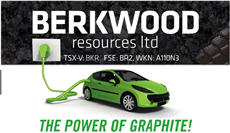
Yet one of these hi-tech/green tech commodity markets has
largely escaped the radar of mining investors. Which one?
Elon Musk of Tesla Motors provides a large
clue:
“Our cells should be called Nickel-Graphite, because
primarily the cathode is nickel and the anode side is
graphite with silicon oxide… [there’s] a little
bit of lithium in there, but it’s like the salt on the salad,” the
CEO explained.
The nickel market is a large, well-publicized market. But who is
talking about graphite? Perhaps the better question is why aren’t
more mining investors talking about the New Black Gold?
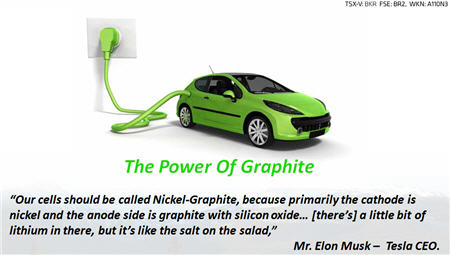
The fundamentals for the graphite market are very compelling.
This is a specialty mineral in that it does not naturally occur in
the same abundance as many of the larger metals and minerals
markets. At the same time, graphite possesses some extraordinary
properties.
Graphite is a carbon-based mineral that is geologically similar
to diamonds. However, graphite offers one very important property
not possessed by the more aesthetically-pleasing form of carbon.
Graphite is highly conductive of electricity. This opens up
numerous energy-based applications for graphite – including
lithium-ion batteries.
As a smaller market, investors seeking to gain exposure to this
vitally important mineral have only a limited number of investment
options. For junior mining investors, one company offers a
compelling investment opportunity: Berkwood Resources Ltd.
(TSXV:
BKR ,
OTC: CZSVF, FSE: A2DNV4 ).
The Company is led by CEO Thomas Yingling. In a conference call
with Stockhouse Editorial, a single point immediately stood out.
Thomas Yingling hates risk. He hates it for his Company. He hates
it for the Company’s shareholders.
BKR’s flagship property is the Lac Gueret Extensions Project,
located in Quebec, perhaps Canada’s most exploration-friendly
jurisdiction. The Berkwood management team has made it its driving
mission over the past six years to de-risk this project to
the maximum degree possible.

How? It starts with diligently working through all of the
lower-cost forms of exploration work. First Berkwood did an
airborne Mag-EM survey of the prospective zones. Then BKR moved to
ground geophysical targeting, to confirm the large magnetic
anomalies.
After that, BKR advanced to a program of surface sampling, which
yielded surface assays as high as 36.3% carbon
(graphite). It was only after thoroughly engaging in these
preliminaries that the Company was satisfied that it was finally
time to move a drill rig on site.
Thomas Yingling is no neophyte to the mining industry. He has
logged more than 23 years of experience in the industry, including
serving as President and CEO of several other public companies in
the resource space. Along the way, Yingling has gathered an
understanding of how to conduct exploration operations in a manner
that conserves shareholder capital by minimizing the level of
risk.
The CEO explains:
There is an old saying in the junior mining industry, “Why
ruin a great project by drilling it?” This is because more often
than not, drill results are poor and it kills the project. Berkwood
has done the opposite. We have intersected graphite in every drill
hole completed to date!”
Through methodically conducting all of this preliminary work,
Berkwood has avoided “ruining” its flagship Project. Now was the
time to sink some drill holes into these highly prospective targets
– and produce the drill results craved by mining investors.
On August 16,
2017; BKR announced the commencement of the first
drilling program at Lac Gueret: up to 18 drill holes in the Zone 1
target area. On August 22,
2017; Berkwood announced it had intersected graphite
mineralization on its first two holes. By September 6th;
the Company was reporting 10-out-of-10 on its
drilling to date – a perfect record. Assays are
pending.
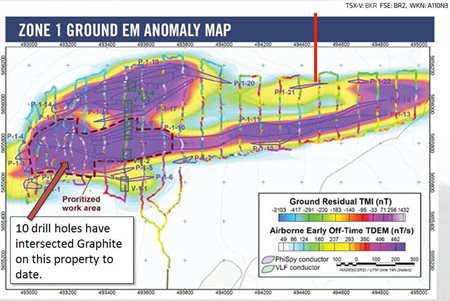
Probably the least-surprised people with respect to these
results are the BKR management team. Their high expectations were
only based in part on their diligent preliminary work. Why is La
Gueret described as an “Extensions Project”? It is because BKR’s
property is on-strike and adjacent to a high grade graphite deposit
being developed by Mason Graphite – Mason’s “Lac Gueret
Deposit”.
A visit to that company’s website is illuminating:
Mason Graphite is a Canadian graphite mining and processing
company focused on the development of the Lac Guéret project
located in northeastern Quebec, where the graphite grade is
believed by management to be among the highest in the
world. [emphasis mine]
Grades “among the highest in the world”: if you’re a junior
mining company focused on graphite, being next-door to this deposit
is a great place to be situated. BKR’s location has also
substantially reduced the risk in this project.
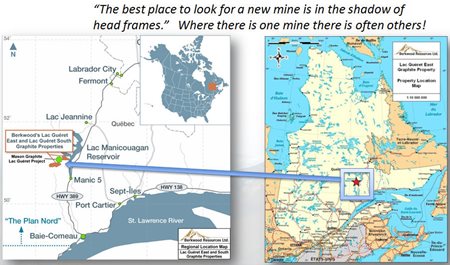
It’s not just the fact that Berkwood’s graphite Project is
adjacent to this high-grade deposit. Mason Graphite is steadily
advancing its own project toward production. To facilitate this
mining project (and others), the provincial government is making a
$400 million infrastructure investment, committed toward
improvements of HWY 389.
HWY 389 passes right past the Berkwood property and these
improvements will significantly improve access to Lac Gueret. This
improved access will reduce exploration and developments costs,
further de-risking BKR’s graphite Project.
Thomas Yingling modestly observes that Berkwood can’t take any
credit for how development of the Mason Graphite project has
reduced the risk for BKR. However, management does earn kudos for
finding and acquiring this ideally situated graphite land
package.
With graphite, grades are only a part of the equation. Like
diamonds, graphite occurs naturally in different qualitative forms.
For industrial purposes, the naturally occurring graphite that is
in greatest demand is the “large flake” form of graphite. The Mason
Graphite deposit (and the Lac Gueret Project) host large-flake
graphite.
Where has the world previously been obtaining most of its
graphite supply? China. In 2016; China
produced 780,000 metric tonnes of graphite, more than four times as
much as the next-leading producer: India. Here is where the
dynamics of the graphic market become especially interesting.
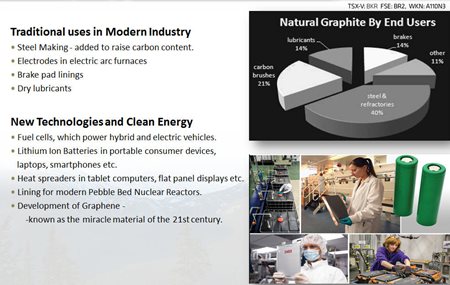
Going back as far as December 2014, Benchmark Mineral
Intelligence was suggesting that China could have reached “peak
graphite” in terms of its production level. That’s the supply side.
On the demand side, in May 2016
Benchmark was projecting that graphite demand from lithium-ion
batteries would triple in just four years.
Flattening production from the world’s leading producer combined
with a tripling of demand for the graphite used in electric
vehicles: where will this extra graphite come from?
Turning back to Tesla, that company has already famously
proclaimed its intent to supply its North American
“gigafactory” with metals and minerals only provided from North
American sources. How much graphite is produced in North America?
Not much.
Mexico and Canada rank #6 and #7 in global production. But (as
of 2016) Mexico produced a mere 22,000 metric tonnes of graphite
and Canada produced 21,000 metric tonnes. Combined, these two
nations produce little more than 5% as much graphite as China. The
United States doesn’t even rank in the top-10.
Where will Tesla get its North American graphite?
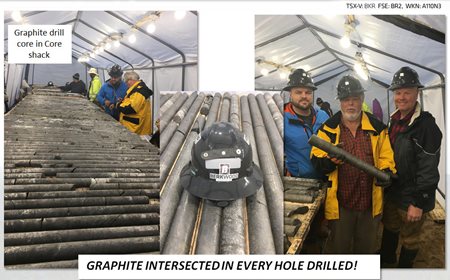
Over the medium term, one answer to that question might be Mason
Graphite. Their Feasibility Study boasts a post-tax IRR of over
34%. Cap-ex is a modest $165.9 million and the projected
construction timeline is a mere 13 – 16 months.
This may lead investors to a second question. Given the very
attractive economics of Mason Graphite’s project, why buy into
Berkwood Resources?
Market cap for Mason Graphite: $203
million.
Market cap for Berkwood Resources: $6.6
million.
Two next-door neighbours with virtually identical geology. Mason
Graphite is clearly currently in the lead in terms of the level of
development. However, the two companies may ultimately end up in
the same place. For investors looking further down the road, BKR is
also holding two other green metals exploration properties.
Meanwhile, Berkwood is sitting in the middle of a very promising
drill campaign, with its $6.6 million market cap, and with
(potential) investors already knowing that the Company has hit on
its first 10 drill holes as they await the assay results. Shrewdly,
management recently staked-out additional claims,
quintupling the size of the land package. For
small-cap mining investors, this is a very intriguing scenario – to
say the least.
Investors buying shares today will be buying into more than a
promising project. Including CEO Thomas Yingling’s 23 years of
experience, the BKR management team has collectively amassed a
century of mining experience. Berkwood’s field work has
particularly benefitted from the experience and expertise of Edward
Lyons, PGeo (Project Lead) and Michel Robert (Advisor).
This is a Company focused on structure: geology, management, and
shares.

Berkwood is confident it has acquired the geological structure
necessary for mining success. It has assembled a management
structure capable of executing on this promising geology. And it
has maintained a (tight) share structure that will allow BKR
shareholders to fully participate in the success of the Lac Gueret
Extensions Project – only 18.5 million shares
outstanding.
Connecting the dots, we have a Company with a market cap of only
$6.4 million. It’s holding a highly prospective property in a
rapidly emerging commodity market. It’s already hit on its first 10
drill holes on this property, with assay results imminent.
Going back as far as 2014, industry analysts were already
pointing to graphite as “the new black
gold”. As investors await the results on BKR’s first
drill holes, they may be contemplating some “gold” of their own:
investment profits.
|